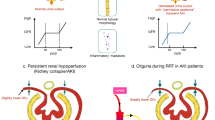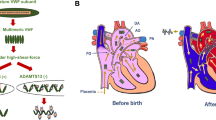Abstract
The degree of hemolysis was investigated in intact and nephrectomized rats after administration of phenylhydrazine. Hemolytic (phenylhydrazine) anemia in nephrectomized animals is manifested by a smaller decrease in the total erythrocyte count, the percentage of51Cr-labeled erythrocytes, and the intensity of the reaction for hemosiderin in tissues of the reticuloendothelial system. A lower degree of erythrodieresis was found in nephrectomized rats and after acute unreplaced blood loss. Perfusion of blood through the kidney of anemized rats leads to an increase in the plasma potassium concentration of the perfusion fluid, a decrease in the electrophoretic mobility and hemolysis time of the erythrocytes, an increase in their fragility, and a decrease in the proportion of protein fractions with molecular weights of between 74,500 and 27,000 in the erythrocyte stroma.
Similar content being viewed by others
Literature Cited
N. A. Gorbunova, in: The Pathophysiology of Erythropoiesis [in Russian], Sverdlovsk (1965), pp. 90–98.
N. A. Gorbunova, “Posthemorrhagic erythrodieresis, its mechanism and its role in blood regeneration,” Author's Abstract of Doctoral Dissertation, Moscow (1971).
I. I. Gitel'zon, I. A. Terskov, and S. E. Mochkina, Collected Scientific Transactions of Krasnoyarsk Medical Institute [in Russian], Vol. 5 (1958), p. 158.
N. M. Novikov, in: Problems in Pathophysiology of Blood Regeneration [in Russian], Sverdlovsk (1968), pp. 13–17.
N. M. Novikov and L. I. Ershova, in: Problems in Spicial Pathological Anatomy [in Russian], Barnaul (1973), pp. 180–182.
N. S. Poluéktov, Methods of Analysis by Flame Photometry [in Russian], Moscow (1967).
Ya. G. Uzhanskii, Vrach. Delo, No. 24, 1049 (1932).
Ya. G. Uzhanskii, in: Physiological Mechanisms of Blood Regeneration [in Russian], Moscow (1968).
N. A. Fedorov and N. A. Gorbunova, Pat. Fiziol., No. 6, 65 (1963).
S. S. Kharamonenko and A. A. Rakityanskaya, Electrophoresis of Blood Cells under Normal and Pathological Conditions [in Russian], Minsk (1974).
R. E. Bernstein, J. Clin. Invest.,38, 1572 (1959).
S. Grey and K. Sterling, J. Clin. Invest.,29, 359 (1950).
L. G. Lajtha, The Use of Isotopes in Hematology [Russian translation], Moscow (1963).
H. Maurer, Disc Electrophoresis and Related Techniques of Polyacrylamide Gel Electrophoresis. De Gruyter, New York (1971).
A. G. E. Pearse, Histochemistry: Theoretical and Applied, Little, Brown and Co., Waltham, Mass. (1960).
R. H. Reiff, J. Y. Nutter, D. M. Donohue, et al., Am. J. Clin. Path.,30, 199 (1958).
S. A. Rosenberg and G. Guidotti, J. Biol. Chem.,243, 1985 (1968).
Rights and permissions
About this article
Cite this article
Novikov, N.M., Blyum, L.I. & Stagis, A.V. Role of the kidneys in the mechanism of erythorodieresis in hemolytic (phenylhydrazine) and acute posthemorrhagic anemia. Bull Exp Biol Med 82, 1635–1638 (1976). https://doi.org/10.1007/BF00790369
Received:
Issue Date:
DOI: https://doi.org/10.1007/BF00790369




